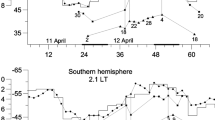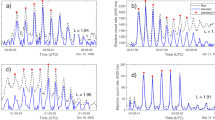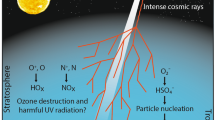Abstract
THE region of the Brazilian geomagnetic anomaly presents an interesting opportunity for the study of precipitation of charged particles of the inner radiation belt into the atmosphere below. Some recent studies based on direct and indirect observations (refs 1–3 and our unpublished work) show that the precipitating flux increases appreciably during the period of a geomagnetic storm. The present note provides another evidence in this direction.
This is a preview of subscription content, access via your institution
Access options
Similar content being viewed by others
References
Martin, I. M., Rai, D. B., da Costa, J. M., Palmeira, R. A. R., and Trivedi, N. B., Nature, 240, 100, 84 (1972).
Trivedi, N. B., Rai, D. B., Martin, I. M., and da Costa, J. M., Planet. Space Sci., 21, 1699 (1973).
Abdu, M. A., Ananthakrishnan, S., Coutinho, E. F., Krishnan, B. A., and Da S. Reis, E. M., J. geophys. Res., 78, 5830 (1973).
Martin, I. M., thesis, Univ. Toulouse (1974).
Pfitzer, K., Sharad, K., and Winckler, J. R., Space Res., 6, 702 (1966).
Author information
Authors and Affiliations
Rights and permissions
About this article
Cite this article
MARTIN, I., RAI, D., PALMEIRA, R. et al. Enhanced low-energy gamma rays at balloon altitude in the Brazilian magnetic anomaly. Nature 252, 25–27 (1974). https://doi.org/10.1038/252025a0
Received:
Revised:
Issue date:
DOI: https://doi.org/10.1038/252025a0
This article is cited by
-
High-energy electron and gamma-ray fluxes in the Brazilian Magnetic-Anomaly Region
Il Nuovo Cimento C (1994)



